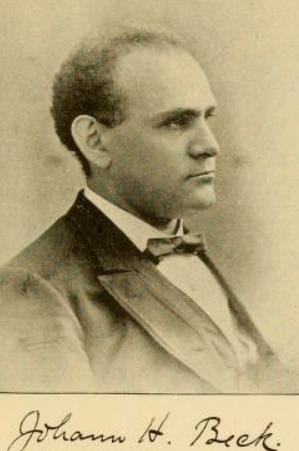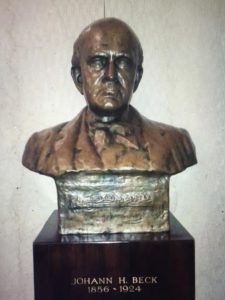Johann Heinrich Beck
(1856–1924), whom Cleveland music historian J. Heywood Alexander
called “a pivotal figure in the history of chamber music in Cleveland.” Beck spent his entire life here, except for three years at the Leipzig Conservatory. At 26, he made his debut as violinist and composer with his String Quartet in c minor, which had its world
premiere at the famous Leipzig Gewandhaus in May of 1882 to excellent critical notice. Beck’s Sextet in d minor was performed at least 10 times between 1887 and 1895 in New York, Boston, Detroit, Cincinnati, Cleveland and Columbus. The New York Tribune called it “The gem of the afternoon…. We doubt there is a composer in this country that could match his slow movement in this sextet.” “One is not bored by a single measure,” said the Cincinnati Courier, “indeed in that quality of naturalness and spontaneity it is pre-eminent among the many large and earnest works which have lately been written by our rising generation of musicians.”
“It is a pity such a splendid work is so seldom heard,” Cleveland Press music critic Wilson G. Smith, past president of the Music Teachers National Association, wrote in 1917, calling it “the foremost composition of its kind yet written by an American.”
Beck’s large-scale compositions were also widely performed. Skirnismal, part of a large-scale multi-part work based on the Icelandic epic known as the Elder Edda, was performed in 1890 by the Theodore Thomas Orchestra (as the Chicago Symphony was then known after its eminent founder). The Kiss of Joy was performed in Cleveland in 1900, and at the St. Louis Exposition in 1904 by special request of the music committee, as were Beck’s compositions Liebeslied and Meeresabend, for voice and orchestra.
In 1919 the newly formed Cleveland Orchestra played Beck’s Lara overture (inspired by Byron’s poem) in the city’s new Masonic Hall, where it “was greatly enjoyed.” New York’s Musical Courier called Beck “one of the strongest of the group of young American composers,” observing that his work “is laid on lines infinitely broader than those of many of the others. He is no trifler, but a vigorous, scholarly and dramatic writer.” Beck was invited to conduct his own works with several major orchestras including the Boston Symphony and the Thomas Orchestra (as the Chicago Symphony was then known, after its illustrious founder). Franz Arens took his Symphonic Scherzo in A to Europe, playing it in Vienna, Dresden, Leipzig and Hamburg.

His sextet was called “the foremost composition of its kind yet written by an American”(Photo at commonswikipedia.org)

Ann Pfenninger’s bronze tribute to Beck, on display at Cleveland Public Library
Heard frequently in concert as a violinist, he organized the Schubert String Quartet and later the Beck String Quartet and gave frequent concerts during the 1880s.
“Looking back over the Cleveland musicians who have left indelible impressions on my memory, the name of Johann H. Beck looms large,” wrote Walter Logan in the Cleveland Weekly Review of June 17, 1933. “I know of no other Cleveland musician in the past half century that has left so pronounced a mark on the musical progress of Cleveland than has this distinguished violinist and composer.” A bronze bust of the composer by Cleveland sculptor and Cleveland School of Art (now CIA) graduate Anna Pfenninger is prominently displayed at the Cleveland Public Library, which has the sheet music for some 18 of his compositions for violin (including All’ Ongarese, Berceuse & Polonaise, and Song of the Mill-stream), cello, string quartet, his Sextet in d minor, Aus Meinem Leben (tone poem for orchestra) and his Lara overture after Byron.
- Cleveland-based art historian Marianne Berardi tells the story of Pfenninger and
the bust in the 88-page catalogue she wrote for a 1915 ARTneo exhibition, A Great Joy: The Women’s Art Club of Cleveland.) Johann Beck is buried in Woodland Cemetery.